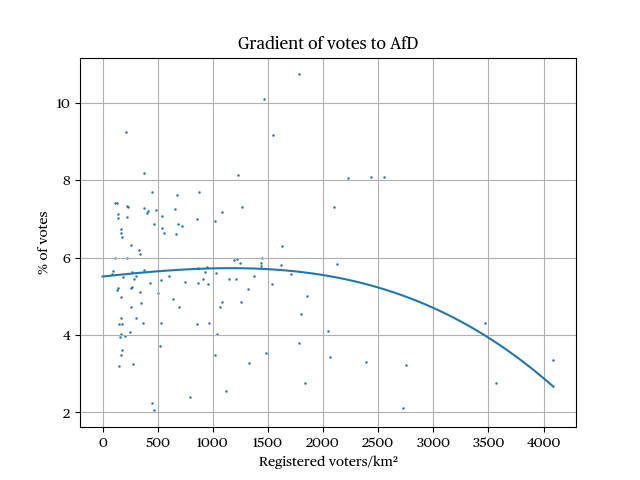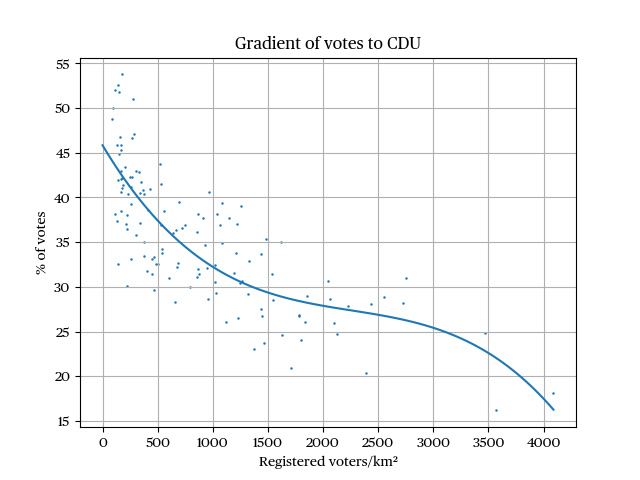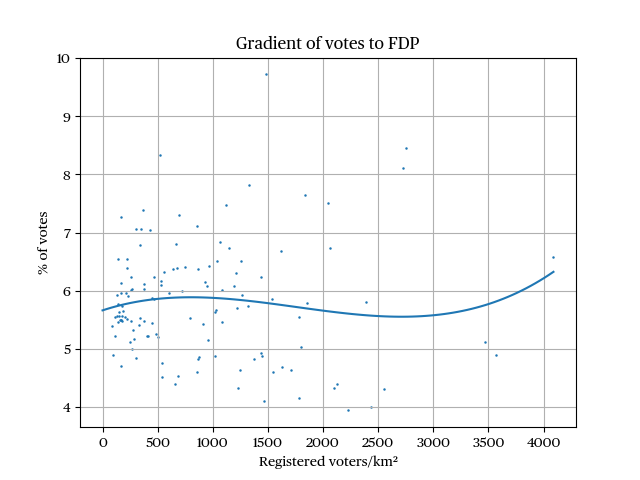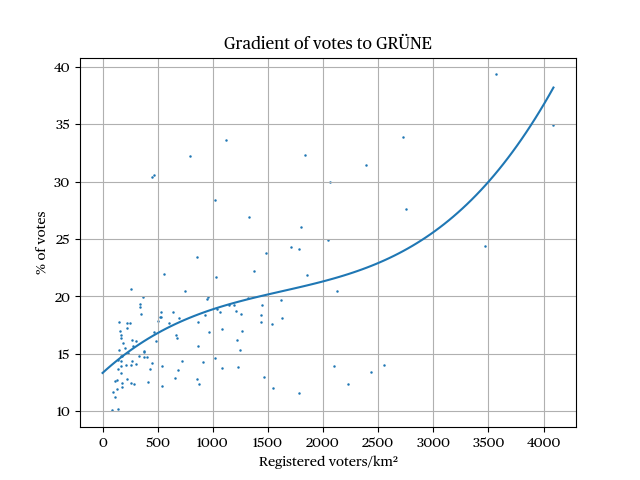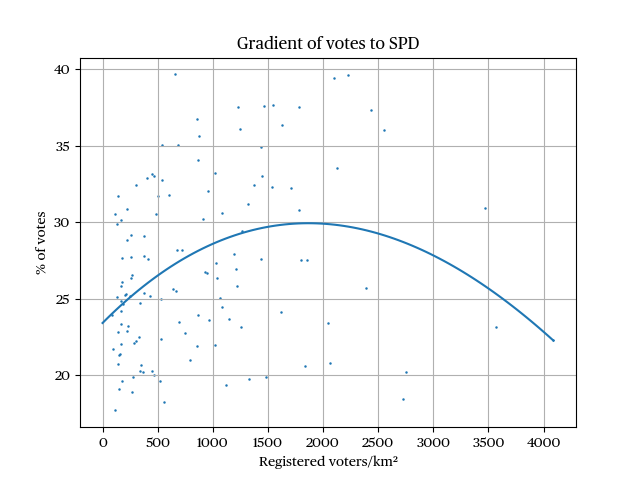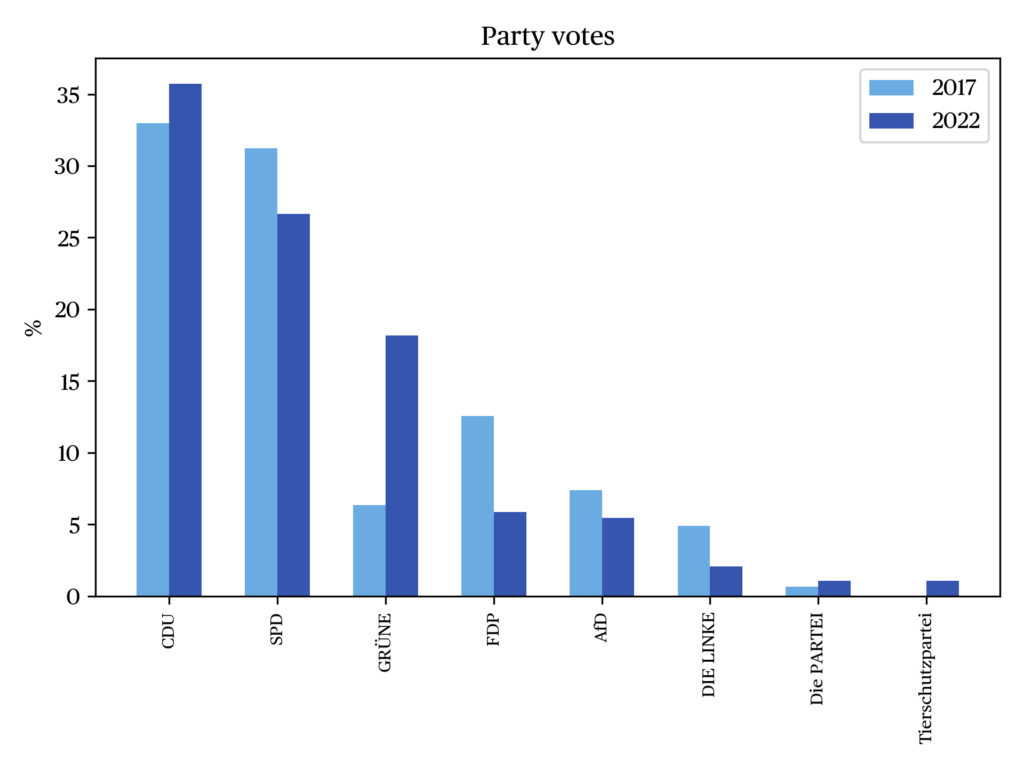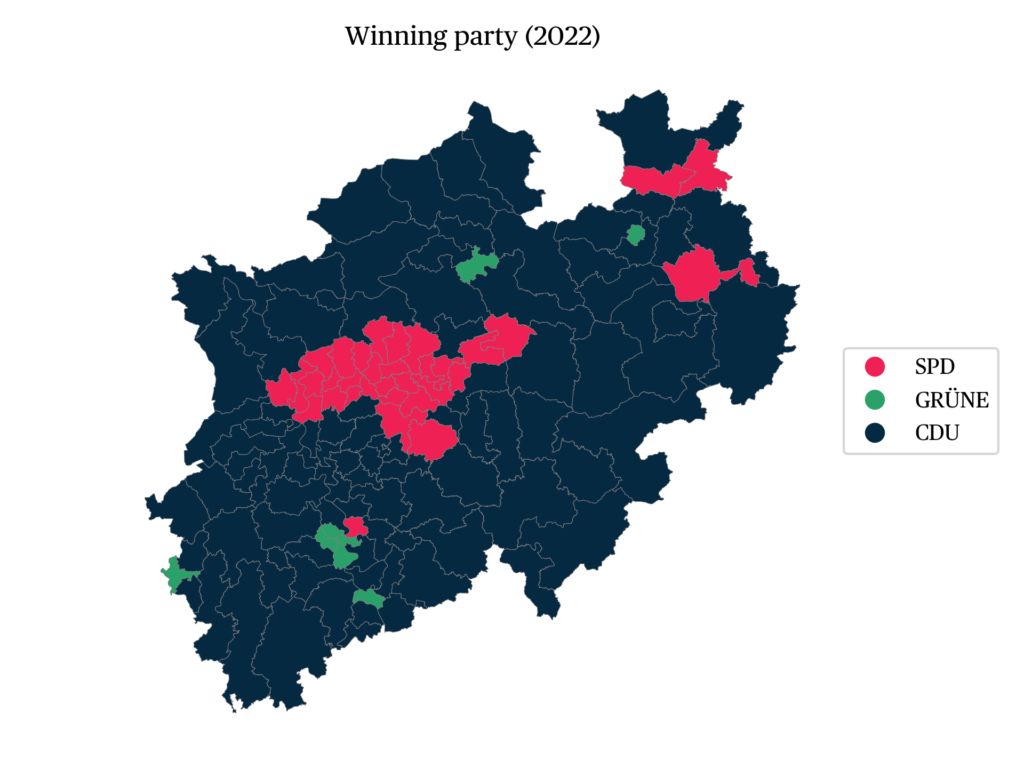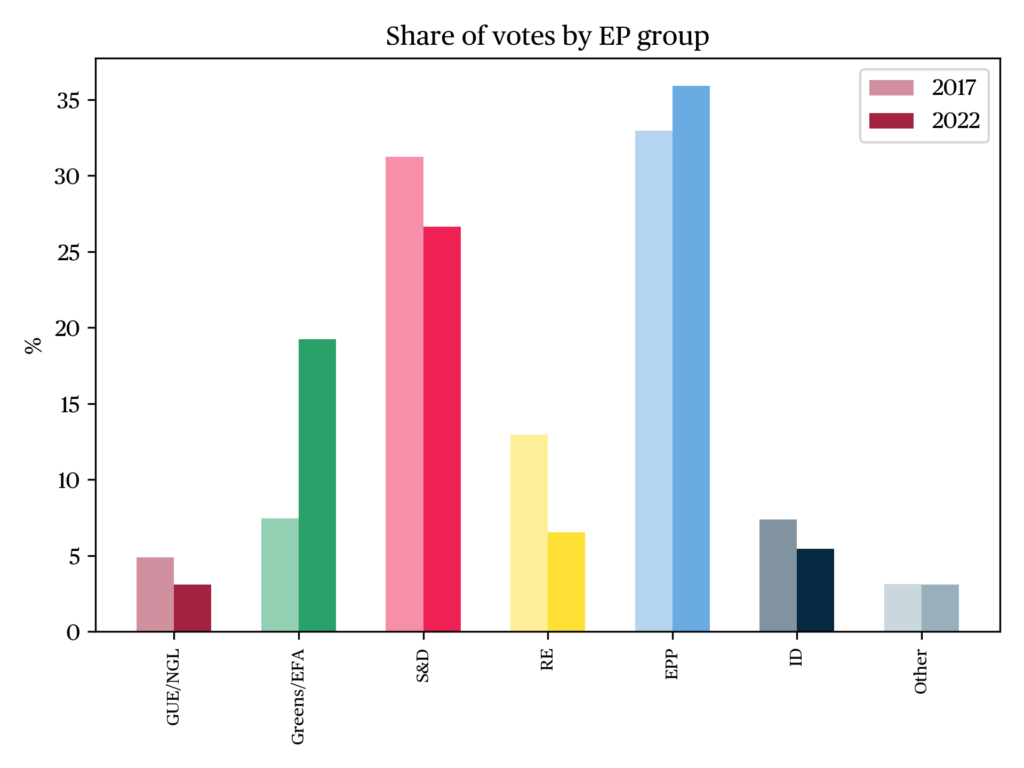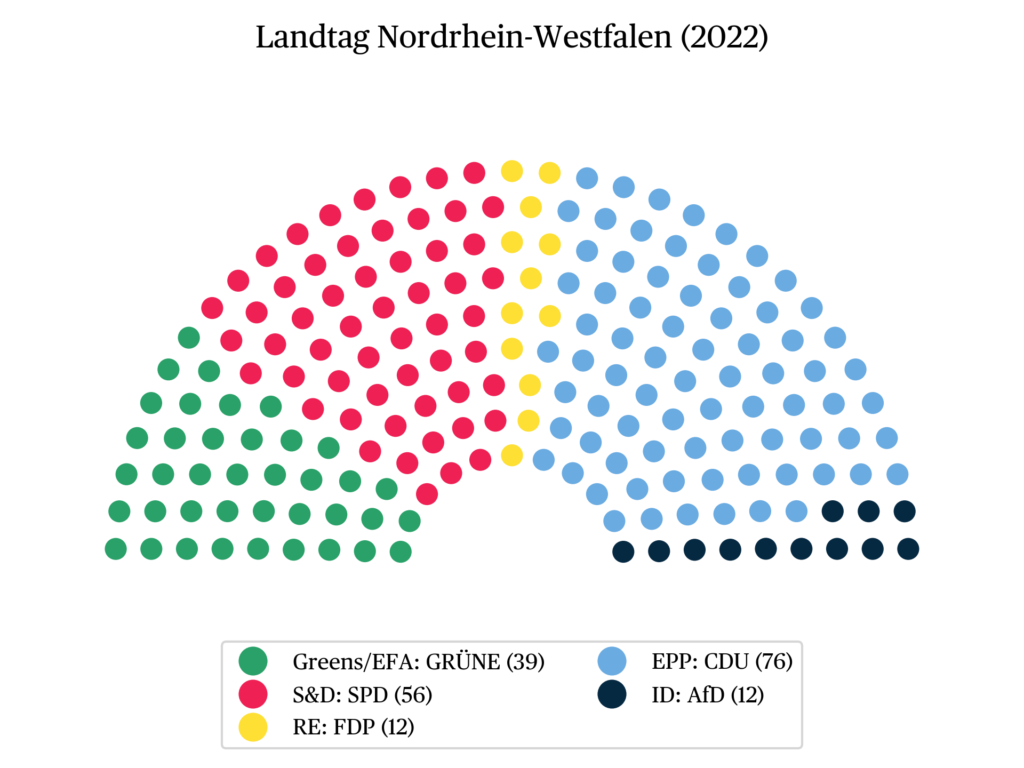Regional election in North Rhine-Westphalia, 15 May 2022
Constantin Wurthmann
Researcher at GESIS – Leibniz-Institute for the Social ScienceIssue
Issue #3Auteurs
Constantin Wurthmann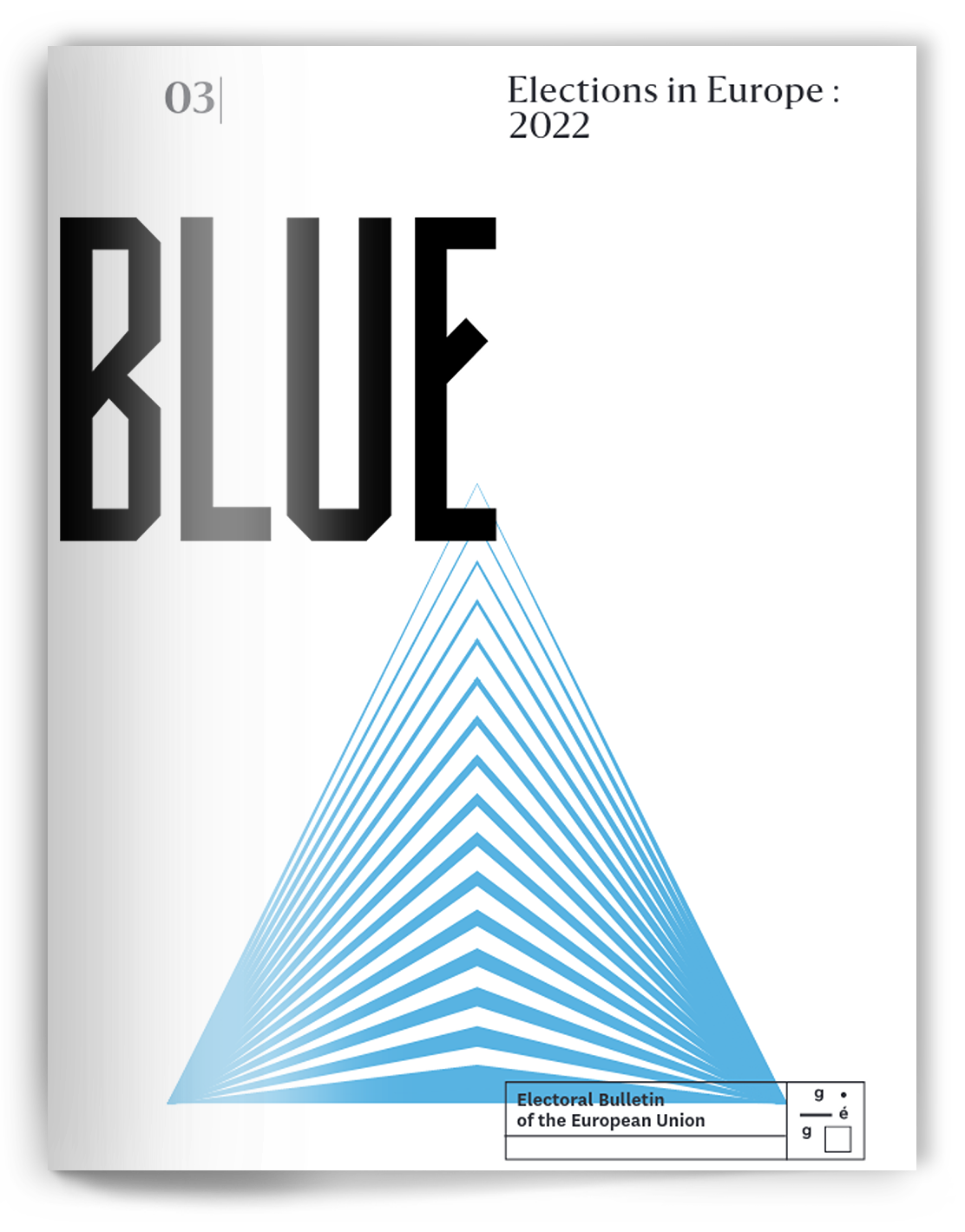
Issue 3, March 2023
Elections in Europe: 2022
In Germany, the state election in North Rhine-Westphalia (NRW) is often, and not without reason, dubbed a ‘small[er] federal election’ (Skroblies 2019: 159). With just under 18 million inhabitants, NRW is the most populous state in the Federal Republic of Germany, and its elections have always had, and probably still have, a direct impact on federal politics (Korte 2020, 216-217). It is often said that whoever can become head of government (minister-president) of NRW is also in a key position to lead the entire country as chancellor; a thought to which Armin Laschet of the Christian Democratic Union of Germany (CDU), who lost the 2021 federal election and had been in office NRW until then, may well have succumbed. Following his defeat, Laschet eventually resigned as Minister-President to serve on the back benches of the Bundestag, while Hendrik Wüst (CDU), who had been his Minister of Transport, was elected as his successor by the Landtag of North Rhine-Westphalia. From the outset, Wüst’s election appeared to be without alternative, as all his potential contenders were prevented from running by a peculiarity of NRW’s electoral law: article 52, paragraph 1, of the NRW constitution requires that the Minister President be elected from among the members of the state parliament (Korte 2020: 57).
Hendrik Wüst took office as Minister-President of NRW on 27 October 2021 — 200 days before the upcoming election —, leading a coalition of the CDU and the Free Democratic Party (FDP). The NRW election was widely perceived as the first major electoral test to be faced by the new federal government, composed of the Social Democratic Party of Germany (SPD), Alliance 90/The Greens (Grüne) and FDP — unlike the Saarland election, which took place two months earlier (Minas 2022).
The SPD’s and the Greens’ candidates, Thomas Kutschaty (SPD) and Mona Neubaur (Greens), were running for the office of Minister President, while the FDP, with its top candidate Joachim Stamp — a minister under Wüst —, aimed at being the junior partner of the future government. Although Stamp repeatedly expressed that the FDP would like to continue its successful cooperation with the CDU, he also emphasised the political independence of his liberal party when it comes to possible alliances, stating that the FDP was not committed to the CDU as a partner — a boomerang that came back on election night and gave the FDP the final knockout after a chaotic election campaign without substantive orientation.
The result was the first coalition of the CDU and the Greens in the most populous state of the Federal Republic of Germany. For the first time in over 40 years, two parties from different political camps would govern together. The purpose of the present analysis is twofold: we will put into perspective the results of the NRW state election and, at the same time, give an overview of the factors that have influenced the voting behaviour of NRW citizens. In the course of our analysis, we will dwell on the question of whether the formation of a government of Christian Democrats and Greens was without alternatives, or which other alternative options would have existed, but were ultimately rejected. (In terms of content, for example, a coalition of the CDU and the SPD would presumably have involved far fewer compromises, as both parties are more similar in content than the CDU and the Greens.) This article also discusses the challenges facing the newly formed government and the opportunities that could arise from this coalition model, which is new in NRW.
This paper is organised as follows. The next section will first discuss the factors influencing citizens’ electoral behaviour which emerge from the results of NRW surveys. Then, the focus will be on the formation of the coalition and whether this outcome was to be expected from a political science perspective. Finally, regional differences in voting behaviour in favour of the parties now in government (the CDU and the Greens) will be taken as a starting point to argue that the present coalition can not only serve as a model for future governments, but also contribute to the pacification of society as a whole.
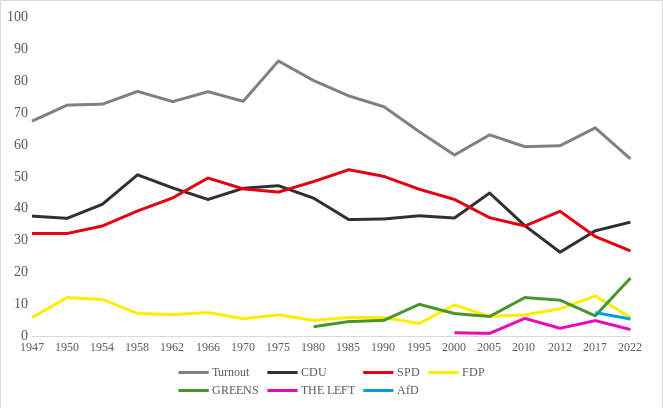
The moment of truth: election night
When the first forecasts appeared on the screens of German televisions at 6 p.m. on 15 May 2022, the outcome was immediately clear: the incumbent government of the CDU and the FDP had been voted out of office – with significant losses for the latter and slight gains for the former. The composition of the future government coalition, however, remained unpredictable until 3.42 a.m. on the morning of 16 May, when the provisional election results were announced. According to these results, the CDU achieved 35.7 per cent (+2.7), the SPD 26.7 per cent (-4.5), the Greens 18.2 per cent (+11.8), the FDP 5.9 per cent (-6.7) and the far-right AfD 5.4 per cent (-2.0) of the vote. The left-wing populist party Die Linke (The Left), which had succeeded in entering the NRW state parliament for the first time in its history in 2010, failed to reach the five-percent threshold needed to obtain seats in parliament, with 2.1 per cent (-2.8). This is the first time since 1975 that the CDU has managed to finish ahead of the SPD in two consecutive state elections in NRW – SPD’s political heartland. With the CDU and the Greens, there are two clear winners of this election – with the Greens even achieving the best election results in their history in NRW. On the other hand, the SPD, FDP, AfD and Left Party suffered losses. The biggest election loser, however, is voter turnout, which plummeted to a historic low of 55.5 per cent (see Figure a).
Why did the election results turn out as described here? In classical election research, a central approach, the so-called social psychological approach (Campbell et al. 1960), distinguishes between general party identification as a long-term structuring feature, and candidate and issue orientation as more short-term features of electoral decision-making. Wüst, who with 200 days in office could not count on any substantial incumbent bonus, still satisfied 48 per cent of all respondents with his work — according to an election survey by the polling institute Infratest dimap. Opposition leader Kutschaty, who was NRW’s minister of justice from 2010 to 2017, only convinced 38 per cent of all respondents. Although these values increased over the course of the year, survey data from January 2022, i.e., four months before the election, was rather revealing. At that time, 75 percent of respondents to a survey said they knew Hendrik Wüst; in contrast, only 46 percent of respondents knew Thomas Kutschaty, while the Green Party’s top candidate Neubaur still achieved an awareness level of 33 percent. Much more concerning was the score of the FDP deputy prime minister, Joachim Stamp: only 38 percent of respondents said they knew the minister and former deputy of Laschet and Wüst, despite him having been in office for five years at the time of the vote (Infratest dimap 2022). For none of the parties did a clear ‘candidate factor’ suffice to explain a significant proportion of the vote. To some extent, leadership may have played a role for CDU voters, 33 percent of whom named Wüst’s personality a decisive factor in their voting decision. Among SPD voters, on the other hand, the candidate factor was only cited by 24 percent. In fact, for all main parties, political programmes appeared as the main reason why they obtained votes on election day. The Greens, in particular, obtained 77 percent of their supporters in that way. The AfD followed with 71 percent and the FDP with 68 percent. The SPD’s supporters also voted mainly for the party on the basis of its election programme, with 49 per cent. The CDU, which is generally not considered a strongly programme-oriented party (Hemmelmann 2017, 143), was chosen by only 40 percent of its supporters on the basis of its programme. According to the respondents, long-term party identification, which is still considered the most central factor in electoral research, did not play a very prominent role (cf. Figure b) — although it should be noted that identification with or perceived closeness to a party does have a major impact on the assessment of candidates or issues.
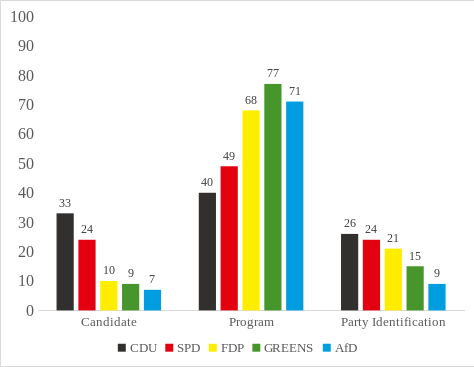

After the Election is Before the Coalition Building Process
The results of the state election led to a general shift of seats in the NRW state parliament in Düsseldorf, which now has 195 members. Of these, 76 are held by the CDU, 56 by the SPD, 39 by the Greens and 12 by the FDP and the AfD respectively. The majority required to form a new state government is 98 MPs. Thus, exactly three coalition formations were mathematically and politically possible after the election. The largest coalition in terms of MPs was a black-red coalition (CDU-SPD), with a total of 132 MPs. The second option, with a total of 115 MPs, was a black-green coalition (CDU-Greens), and the third option, a so-called ‘traffic light coalition’ (SPD-FDP-Greens), with a total of 107 MPs (see the “data” panel).
The political science literature provides various models explaining the formation of coalitions. A common approach is to use indicators of programmatic closeness between the future coalition partners to estimate the likelihood of a given coalition government being formed. But other factors can be considered: for instance, a coalition model is more likely to be adopted the fewer parties are involved in it; this is justified by the fact that parties can also be classified as utility-maximising actors who hope to gain more influence through political offices (Debus 2022, 81). The latter factor could rather easily explain why no ‘traffic light coalition’ was formed after the North Rhine-Westphalia state elections, since three parties would have had to compete for the allocation of government offices. But what about the closeness of the possible coalition parties in terms of programme? One possibility to measure such closeness is the use Wahl-O-Mat data. The Wahl-O-Mat is a tool published by the Federal Agency for Civic Education (Bundeszentrale für politische Bildung), which can be used by citizens to check, on the basis of 38 theses, how much they agree with policy stances of the parties running in an election. The parties themselves select a position between agree, neutral or disagree. Afterwards, users can position themselves on the same 38 propositions and are then shown how much they agree with the content of the corresponding parties. The data is particularly suitable for explaining coalition formation processes because the party positions are taken by the parties themselves and can be quickly evaluated (for the calculation see Wagschal and König 2014). On the basis of this computation of programmatic (dis)coherence, it appears that the parties in a ‘traffic light coalition’ would only have had a minor degree of programmatic overlap. It is therefore understandable that this option was not seriously considered. Nonetheless, this clear rejection of the ‘traffic light’ is not without fault on the part of the FDP, especially since the FDP’s lead candidate Stamp had clung to a continuation of the CDU-FDP coalition for a very long time during the election campaign. Such announcements, which are also referred to as coalition signals in the academic literature, send clear impulses to the potential electorate and can have enormous consequences, as they can influence voting behaviour both negatively and positively (Bahnsen et al. 2020; Debus and Müller 2014). By making very clear that they did not want to abandon their previous coalition partner, the CDU, by entering a coalition with the SPD and the Greens, the FDP had manoeuvred itself into a tactical impasse.
The fact that no black-red coalition of CDU and SPD was formed in NRW after the state elections, although it would have been considerably more coherent in terms of content than the black-green coalition of CDU and Greens that was finally formed (cf. Figure c), can be explained in a similar way.
Indeed, in recent years, the NRW chapter of the SPD had taken a particularly clear stance against coalitions of Christian Democrats and Social Democrats at the national level. Kutschaty himself largely contributed to this positioning. Just as the FDP expressed clear signals against a traffic light coalition, the SPD appeared to reject a coalition with the CDU. A coalition of Christian Democrats and Social Democrats would have run counter to central campaign commitments of the SPD.
So why a coalition of the CDU and the Greens? Since such an alliance was already being discussed as a future coalition option in the run-up to the Bundestag elections — even though, as we know, a different government model was finally adopted — it certainly seems as if the differences in content between these parties are no longer irreconcilable. In some federal states, the CDU and the Greens have either already governed as a pair (Hamburg: 2008-2010), have been confirmed in this government once (Hesse: since 2014; Baden-Württemberg: since 2016) or have recently governed in such an alliance (Schleswig-Holstein: since 2022). With the formation of the black-green coalition, the share of votes that the CDU and the Greens control together in the Bundesrat, the higher chamber of the Federal Republic of Germany, also increases to 21 out of 69 votes — eleven more than the current ‘traffic light coalition’ has. It thus seems to be in the interest of both parties to come closer together in the long term, so that in the event of a new election they will be in a position to push through federal policy projects with the backing of the federal states. Nevertheless, the CDU and Greens’s positions still lie far apart on a number of issues. How these differences can be acknowledged and what significance the formation of a black-green coalition could have for the overall pacification of society will be explained in more detail below.
Black-Green bridge-building between urban and rural areas?
Historically, the major differences between urban and rural regions have contributed to the emergence of parties representing specific, regionally contextualised interests (Lipset and Rokkan 1967). In Germany, however, this classic line of conflict was overlaid by other factors, which is why it was never able to develop any significant political clout. Nevertheless, over the course of time, some parties have been able to strengthen or weaken their regional profile. The CDU, for example, traditionally performs better in rural areas than in urban areas — a consequence of its historically grown proximity to farms and medium-sized enterprises, which are overrepresented in rural areas. The Greens, on the other hand, who have their roots in an urban and academic milieu (Fogt and Uttiz 1984: 225), are particularly successful in urban areas.
Thus, for the first time, the two coalition partners who sit together on the government benches of the state parliament of North Rhine-Westphalia present two widely different profiles: while one partner, the Christian Democrats, positions itself as a decidedly middle-class conservative party and therefore also achieves high election results in rural areas, the other party, the Greens, is particularly popular in urban areas, where it positions itself as an ecological and progressive force (Haffert 2022; Stroppe and Jungmann 2022). The election results for the 2022 NRW state election show that these traditional patterns do not seem to have lost their validity (cf. Figure d).
The electoral data shows that the CDU achieved particularly good results in more rural areas but achieved much lower vote shares in urban areas, while the Greens, conversely, achieved strong election results where population density was particularly high, whereas they did worse when population density was correspondingly low. Population density, which is one of several indicators used to determine the degree of urbanity of a region (Stroppe & Jungmann 2022: 54), paints a picture of regionally contrasting electorates, which the new black-green state government will have to take into account.
The significant differences between the two parties’ programmes make this government alliance seem daring at first glance. Bearing in mind that, at least until the founding of the far-right AfD (Bräuninger et al. 2020: 146), the Greens and the CDU have historically played the role of socio-cultural antipodes to each other in NRW, the alliance appears all the more interesting. On the other hand, a coalition between parties assumed to stand in such fundamental opposition to each other may have the potential to develop a national political impact and to build bridges between strongly differing voter milieus. Not only the black-green coalitions in Hesse, Baden-Württemberg and — more recently — in Schleswig-Holstein have shown that Christian Democrats and Greens can govern successfully and, when possible, continue a government together in the following legislative period. In North Rhine-Westphalia, too, the new black-green coalition could succeed in pacifying long-simmering social conflicts as well as in resolving possible conflicts between urban and rural populations.
Building joint projects out of opposites?
As one of the EU’s largest industrial regions, NRW is no economic lightweight. If the current state government succeeds in reconciling economic and ecological necessities, making NRW more sustainable as an industrial location without losing economic clout, this will also have an impact beyond the state’s borders. Such a coalition could therefore serve as a model for other federal states, but also for other EU member states.
In times of advancing climate change, the new NRW state government faces enormous challenges. In addition to price increases (19 percent), energy supply (16 percent), the war in Ukraine (12 percent) and education policy (12 percent), climate policy (17 percent) was named as one of the central problem areas before the election (Tagesschau 2022). From the Greens’ point of view, it seems all the more prudent that their former top candidate, Mona Neubaur, was able to create her own super-ministry for economy, industry, climate protection and energy during the coalition negotiations. In contrast, social and financial policy, which are also part of the electorate’s priorities, are now in the hands of Christian Democratic ministers – another not unwise move by the CDU in NRW.
The new NRW state government will have to live up to its role as mediator between urban and rural areas. The fact that the CDU is a coalition partner that is primarily successful in rural areas and the Greens are a coalition partner that is primarily successful in urban areas could allow them to build new political bridges. The programmatic differences between the coalition partners have not been an insurmountable obstacle to the formation of a government — even though the Greens, in particular, obtained most of their support from voters who valued their political program, and are under pressure to meet the demands placed on them. NRW Prime Minister Wüst, on the other hand, has yet to show whether he is capable of finding a common ground between opposites, and to carry forward common projects.
The fact that, for the first time since the 1960s, the prime minister of NRW has come from the CDU for two consecutive legislative periods (Korte 2020: 95) can certainly be interpreted as a kind of cultural upheaval. What may be unexpected here — at least in retrospect — is that the former traditional partner of the CDU, the FDP, is increasingly being replaced in this role by the Greens. This is the case in North Rhine-Westphalia as well as in other states, and could be the symbol of a much longer-term change, the outcome of which is not yet foreseeable.
References
Bahnsen, O., Gschwend, T., & Stoetzer, L. F. (2020). How do coalition signals shape voting behavior? Revealing the mediating role of coalition expectations. Electoral Studies, 66.
Bräuninger, T., Debus, M., Müller, J., & Stecker, C. (2020). Parteienwettbewerb in den deutschen Bundesländern. 2. Auflage. Wiesbaden: Springer VS.
Campbell, A., Converse, P. E., Miller, W. E., & Stokes, D. E. (1960). The American Voter. New York: John Wiley.
Debus, M. (2022). Parteienwettbewerb und Wahrscheinlichkeit verschiedener Koalitionsoptionen bei der Bundestagswahl 2021. Politische Vierteljahresschrift, 63: 73-88.
Debus, M. & Jochen, M. (2014). Expected Utility or Learned Familiarity? The Formation of Voters’ Coalition Preferences. Electoral Studies, 34 (1): 54–67.
Fogt, H. & Uttitz, P. (1984). Die Wähler der Grünen 1980–1983: Systemkritischer neuer Mittelstand. In: Zeitschrift für Parlamentsfragen, 15(2): 210–226.
Haffert, L. (2022). Stadt, Land, Frust: Eine politische Vermessung. München: C.H.Beck.
Hemmelmann, P. (2017). Der Kompass der CDU. Analyse der Grundsatz- und Wahlprogramme von Adenauer bis Merkel. Wiesbaden: Springer VS.
Infratest dimap. (2022). Nordrhein-WestfalenTREND Januar 2022. Online. Retrieved 28.7.22.
Korte, K.-R. (2020). Wahlen in Nordrhein-Westfalen. Kommunalwahl. Landtagswahl. Bundestagswahl. Europawahl. 5. überarbeitete und aktualisierte Auflage. Frankfurt am Main: Wochenschau Verlag.
Lipset, S. M. & Rokkan, S.. 1967. Cleavage Structures, Party Systems, and Voter Alignments: An Introduction. In Rokkan, S. & Lipset, S. M. (eds.), Party Systems and Voter Alignments: Cross-National Perspectives. New York und London: Free Press: 1–64.
Minas, M. (2022). Analyse der Landtagswahl 2022 im Saarland. BLUE 3. Paris: Groupe d’études géopolitiques.
Stroppe, A. K. & Jungmann, N. (2022). Stadt, Land, Wahl. Welchen Einfluss hat der Wohnort auf die Wahlentscheidung bei der Bundestagswahl 2021? easy_social_sciences, 67: 49-60.
Tagesschau (2022). Nordrhein-Westfalen. Landtagswahl 2022. Online. Retrieved 28.7.22.
Wagschal, U. & König, P. D. (2014). Alle gleich? Analyse der programmatischen Parteiunterschiede bei Bundestagswahlen auf der Basis des Wahl-O-Mats. Zeitschrift für Parlamentsfragen, 45(4): 782-801.
Zicht, W. & Cantow, M. (2022). Nordrhein-Westfalen. Ergebnisse der Landtagswahlen in Nordrhein-Westfalen. Online. Retrieved 28.7.22.
citer l'article
Constantin Wurthmann, Regional election in North Rhine-Westphalia, 15 May 2022, Oct 2022,
à lire dans cette issue
voir toute la revue






